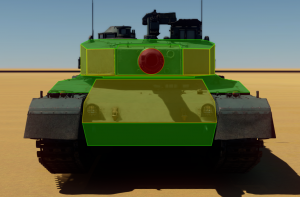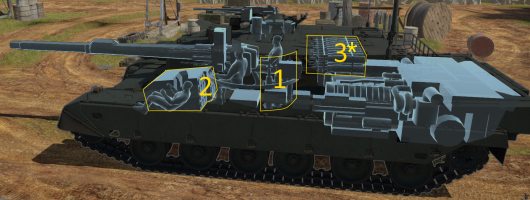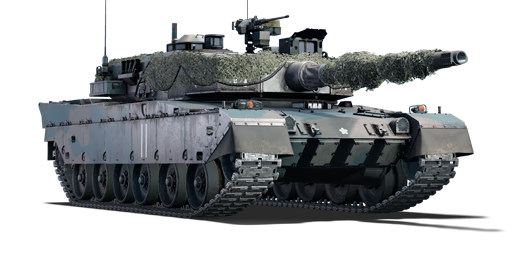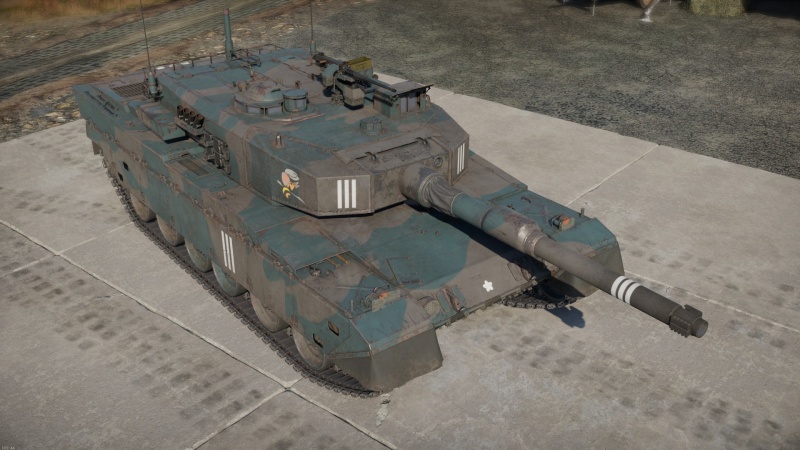Type 90 (B) "Fuji"
| This page is about the Japanese medium tank Type 90 (B) "Fuji". For the other version, see Type 90 (Family). For other uses, see Type 90 (Disambiguation). |
Contents
Description
This Type 90 (B) belongs to the Fuji Tank Instructor Corps (3rd Company), tasked with training the newest aspiring tank crews in their duties and responsibilities as tankers in the JGSDF. Key aspects to learn about the Type 90 MBT include its top-notch features and capabilities, such as its state-of-the-art autoloader, which allows the tank to fire every 4 seconds, and its hydropneumatic suspension, enabling the gun to be depressed or elevated in any direction with the hull's position. Its advanced electronics feature a thermal gunner camera, laser rangefinder, and laser warning system, alerting the crew to any potential enemy targeting the tank. The performance of the Type 90's strong engine, coupled with its below-par armour, dictates tactics that rely heavily on flanking or sniping from a hull-down position, eliminating as many targets in quick succession before retreating to reposition and engage again.
It was introduced in Update "Alpha Strike". Essentially being a backup to the base Type 90s, it does everything the same and offers only minor plates to the hull which won't exactly improve survivability. The only real downside of the plates is the inability to mount a dozer blade like its previous model.
General info
Survivability and armour

The Type 90 MBT sacrifices protection and survivability in order to attain a smaller profile and a lighter vehicle overall (vehicle weight is important in Japan in order to pass over their many bridges). As such, most 'improved' rounds available to other 10.0-10.3 MBTs (such as the Leopard 2A5's DM33, or the Leclerc's OFL 120 F1) will punch through even the Type 90's turret cheeks or upper front plate. It's important to keep in mind that even some autocannon ammunition will easily penetrate some of the weaker sections of the Type 90 from the front.
Despite the mediocre protection, the Type 90 has one main survivability feature: its primary ammunition is stored in blowout-protected compartments, sparing the crew from side shots on the rear of the turret, providing no more than 19 rounds are carried. Unfortunately, however, due to the autoloaded cannon the Type 90 is crewed by only 3, increasing the chances of being disabled from an initial shot.
| Armour | Front (Slope angle) | Sides | Rear | Roof |
|---|---|---|---|---|
| Hull | 25 mm (78°) Driver's hatch 40 mm (47-83°) Upper glacis 40 mm (44°) Lower glacis |
35 mm 10 mm Side Skirts 25 mm Top |
25 mm (17-70°) All rear 15 mm Engine grille |
20 mm (0-8°) Hull roof incl. engine deck 15 mm Engine grille |
| Turret | 40 mm Cheeks incl. Gunner optics 35 mm Mantlet 35 mm Rear Mantlet Plate |
35 mm Forward 33 mm + 80 mm (air) + 40 mm Middle Spaced Armour 12 mm + 80 mm (air) + 35 mm Rear Spaced Armour |
25 mm Turret | 35 mm (83°) Forehead Armour 20 mm Rear turret incl. cupola |
| Composite armour | Front (Slope angle) | Sides |
|---|---|---|
| Hull | Upper glacis 320 - 450 mm Kinetic 420 - 600 mm Chemical Lower glacis 37 mm - 300 mm Kinetic 20 - 380 mm Chemical |
N/A |
| Turret | Turret cheeks 400 - 450 mm Kinetic 640 - 660 mm Chemical Gun mantlet 275 - 375 mm Kinetic 500 - 600 mm Chemical |
Side forward 78 - 400 mm Kinetic 81 - 490 mm Chemical Side middle 77 mm Kinetic 80 mm Chemical |
Mobility
| Game Mode | Max Speed (km/h) | Weight (tons) | Engine power (horsepower) | Power-to-weight ratio (hp/ton) | |||
|---|---|---|---|---|---|---|---|
| Forward | Reverse | Stock | Upgraded | Stock | Upgraded | ||
| Arcade | 81 | 38 | 50.2 | 2032 | 2,862 | 40.48 | 57.01 |
| Realistic | 73 | 34 | 1327 | 1,500 | 26.43 | 29.88 | |
The Type 90 (B) "Fuji" is powered by a 10-cylinder two-stroke diesel engine producing a maximum of 1,500 horsepower at 2400 RPM. Combined with its relatively light weight of only 51.6 tonnes, this gives it an excellent power-to-weight ratio of 29.07. As such, the Type 90 is often one of the first vehicles to reach cap points in a match, and can comfortably flank or move into advantageous positions earlier than many of its contemporaries. This power is transferred to the drive sprockets via an automatic transmission with 7 forward and 2 backward gears, unfortunately limiting the otherwise extremely mobile vehicle to 72 km/h (RB/SB) forwards and -33 km/h (RB/SB) backwards - speeds which it will reach with ease on-road.
The Type 90 (B) "Fuji" also mounts hydropneumatic suspension, allowing it to actively change the vehicle's ride height and angle. This can be used to improve traction on angled surfaces.
Modifications and economy
Armaments
Main armament
The Type 90 L/44 120 mm cannon is a license-produced clone of the Rheinmetall L/44 cannon found on the Leopard 2 series and the M1A1/M1A2. As such, it shares their excellent accuracy and firepower characteristics, with a key advantage: the Type 90 is autoloaded. This results in a flat 4 second reload, better than the peak manually loaded speeds available to the other L/44-mounting vehicles (6 seconds). Additionally, reloads are not hindered by fire or the loss of crew members. The Type 90 has two rounds available to it; the powerful JM33 APFSDS round (based off the NATO DM33 round) and the JM12A1 HEAT-FS round (based off DM12A1). These rounds are more than capable of penetrating any opponent the Type 90 may face, although when facing some later vehicles such as the M1A2 or Leopard 2A5, weak points must be targeted.
| 120 mm Type 90 L/44 | Turret rotation speed (°/s) | Reloading rate (seconds) | |||||||||||
|---|---|---|---|---|---|---|---|---|---|---|---|---|---|
| Mode | Capacity | Vertical | Horizontal | Stabilizer | Stock | Upgraded | Full | Expert | Aced | Stock | Full | Expert | Aced |
| Arcade | 42 | -7°/+10° | ±180° | Two-plane | 28.6 | 39.5 | 48.0 | 53.1 | 56.5 | 4.00 | 4.00 | 4.00 | 4.00 |
| Realistic | 17.9 | 21.0 | 25.5 | 28.2 | 30.0 | ||||||||
Ammunition
| Penetration statistics | |||||||
|---|---|---|---|---|---|---|---|
| Ammunition | Type of warhead |
Penetration @ 0° Angle of Attack (mm) | |||||
| 10 m | 100 m | 500 m | 1,000 m | 1,500 m | 2,000 m | ||
| JM12A1 | HEATFS | 480 | 480 | 480 | 480 | 480 | 480 |
| JM33 | APFSDS | 481 | 478 | 470 | 461 | 450 | 440 |
| Shell details | ||||||||||||
|---|---|---|---|---|---|---|---|---|---|---|---|---|
| Ammunition | Type of warhead |
Velocity (m/s) |
Projectile mass (kg) |
Fuse delay (m) |
Fuse sensitivity (mm) |
Explosive mass (TNT equivalent) (kg) |
Ricochet | |||||
| 0% | 50% | 100% | ||||||||||
| JM12A1 | HEATFS | 1,140 | 13.5 | 0.05 | 0.1 | 2.15 | 65° | 72° | 77° | |||
| JM33 | APFSDS | 1,640 | 4.3 | - | - | - | 78° | 80° | 81° | |||
Ammo racks

| Full ammo |
1st rack empty |
2nd rack empty |
3rd rack empty |
Visual discrepancy |
|---|---|---|---|---|
| 42 | 39 (+3) | 19 (+23) | 1 (+41) | No |
Note:
- Hull empty: 19 (+23) shells.
Machine guns
The Type 90 mounts two machine guns; one pintle-mounted 12.7 mm and one coaxial mounted 7.62 mm. These can be used as deterrent for low-flying aircraft, clearing light obstacles or crew from open-top vehicles, or spotting enemy vehicles.
| 12.7 mm M2HB | ||||
|---|---|---|---|---|
| Mount | Capacity (Belt) | Fire rate | Vertical | Horizontal |
| Pintle | 1,000 (200) | 577 | -8°/+60° | ±120° |
| 7.62 mm Type 74 | ||||
|---|---|---|---|---|
| Mount | Capacity (Belt) | Fire rate | Vertical | Horizontal |
| Coaxial | 4,500 (250) | 701 | N/A | N/A |
Usage in battles
The Type 90 (B) "Fuji" is an extremely capable vehicle in the hands of an experienced tanker, but heed must be paid to the vehicle's weaknesses at all times.
Rural Combat
The Type 90 (B) "Fuji" is very capable in rural combat where cover is plentiful and flanking routes are available. It should ideally be used for early flanks where available (such as the eastern flank on Maginot Line) or when unavailable, pushing quickly for early captures before moving to a nearby protected location to hold that point. It's important to be aware of which routes might be sniper-covered early, as many snipers (such as the Challenger 2 or Ariete PSO) will easily penetrate the Type 90 (B) "Fuji", even at range - avoid giving them the opportunity.
Urban Combat
The Type 90 (B) "Fuji" can prove itself to be an excellent urban combat vehicle, primarily due to its mobility and reliably fast reload. As in rural combat, an early push for a cap can prove viable before moving into a protected position, although often by the time the capture is completed enemy targets will be nearby. Early flanking (such as around the sides of American Desert) is also viable.
Notable Targets
- Challenger 2 - The Challenger 2 is often found as a sniper due to its pin-point accuracy, good reload and excellent turret armour. The Type 90 should never be used to face a sniping CR2 head-on, but instead should attempt to flank or force engagements at close range where weak spots are easily targeted.
- M1A2 Abrams - The M1A2 Abrams has excellent frontal protection and can prove tricky to discern from earlier models in the heat of a battle. As a general rule it's preferable to aim for the gun mantlet or turret ring on any Abrams, despite the fact that JM33 will penetrate nearly anywhere on early models - better safe than sorry.
- Leopard 2A5 - The Leopard 2A5 is very well protected, although JM33 will punch through its hull without any significant trouble. Avoid fighting a hull-down 2A5 head-on, rather taking flanking routes when available. If no choice is presented, aim for the gun mantlet or the turret ring.
- T-80U - The T-80U is extremely well protected from the front, and care should be taken when engaging - aim for the driver viewport or the lower front plate; or where these are not options try to disable its gun through the mantlet. If flanking, side shots will often despatch the T-80U quickly.
- Leclerc - The Leclerc is extremely fast, with a power-to-weight ratio not far short of the Type 90's. When pushing early for caps or flanks, be aware that the Leclerc may be one of the first vehicles you'll counter.
- Leopard 2K - The Leopard 2K has the best power-to-weight ratio of any MBT currently in War Thunder, and it will often be capable of getting to positions before the Type 90. Keep in mind that it can be penetrated anywhere, but aware the 'bouncy' armour; aim carefully.
- AMX-40 - The AMX-40 is extremely mobile and caution is advised when pushing early. Fortunately, the AMX-40 has negligible protection and JM33 will make quick work of it.
Pros and cons
Pros:
- Relatively small profile despite visual similarities to the Leopard 2A4
- 120 mm cannon with autoloader, 4-second reload unaffected by crew or fire
- Extremely mobile, high power-to-weight ratio
- Fitted with Hydropneumatic suspension, although this can only be operated when stationary
- JM33 APFSDS round is competitive (identical to DM33, the 'improved' round on the Leopard 2A5)
- Primary ammunition storage protected within blow-out containment in the rear of the turret
Cons:
- Despite having composite protection in the turret and upper front plate, it's insufficient protection for many of the tanks it will face
- Only three crew, a well-placed shot can easily cause a crew knock-out
- Forced to use a mediocre round prior to researching the tier III JM33 HEATFS
- JM33 HEATFS round struggles against higher-rank opponents if not aimed at weak spots
- Can only carry 19 ammunition before additional ammo is stored in the less protected hull racks
- Slow elevation/depression speed for the main gun
- Slower turret traverse than most other MBTs
History
Development of the Type 90 began almost immediately after the introduction of the Type 74 into service, with the Japanese High Command already looking for a superior replacement. A central aspect of the new machine would have to be the ability to take on and defeat the new Soviet T-72 main battle tank. With that in mind, Japanese engineers began working on a prototype design, which would see completion in 1980. Two prototypes of this initial design were built, tested and improved upon between 1980 - 1986.
Testing resumed in 1986 with a second batch of four prototype vehicles, featuring a number of improvements over the initial two. The most significant change included the replacement of a Japanese-made 120mm smoothbore gun with the established Rheinmetall 120 L/44, most notably used by the M1A1 Abrams and Leopard 2 at the time. The decision to change the gun from a domestic one to a licence-built alternative most likely came as a measure to reduce production costs. However, unlike the MBTs of western armies, the designers of the Type 90 opted to equip the tank with an autoloading mechanism, making it the only production vehicle that did so in combination with the Rh 120 cannon. Further testing and army trials of these prototypes was conducted during the late 80s before the Japanese army formally introduced the tank into service in 1990 as the Type 90. Production of the Type 90 began in 1990 and continued until 2009, with 341 vehicles made.
- From Devblog
Media
- Skins
- Videos
See also
- Related Development
- Other vehicles of similar configuration and role
External links
Paste links to sources and external resources, such as:
- topic on the official game forum;
- other literature.
| Japan medium tanks | |
|---|---|
| Type 97 | Chi-Ha · Chi-Ha Kai · Chi-Ha Kai TD · Chi-Ha Short Gun |
| Type 1 | Chi-He · Chi-He (5th Regiment) · Ho-I |
| Type 3 | Chi-Nu · Chi-Nu II |
| Type 4 | Chi-To · Chi-To Late |
| Type 5 | Chi-Ri II |
| Type 61 MBT | ST-A1* · ST-A2* · ST-A3* · Type 61 |
| Type 74 MBT | ST-B2* · Type 74 (C) · Type 74 (E) · Type 74 (F) · Type 74 (G) |
| Type 90 MBT | Type 90 · Type 90 (B) · Type 90 (B) "Fuji" |
| Type 10 MBT | TKX (P)* · TKX* · Type 10 |
| Other | Ka-Chi |
| USA | ▅M4A3 (76) W · ▅M47 |
| *Prototype | |
| Japan premium ground vehicles | |
|---|---|
| Light tanks | Ha-Go Commander · Type 16 (FPS) |
| Medium tanks | Chi-Ha Short Gun · Chi-He (5th Regiment) · Ka-Chi · Chi-Nu II · Type 74 (G) · Type 90 (B) "Fuji" |
| Heavy tanks | Ro-Go · ▅Heavy Tank No.6 |
| Tank destroyers | Ho-Ri Prototype · Type 75 MLRS |
- Ground vehicles
- Japan ground vehicles
- Seventh rank ground vehicles
- Premium ground vehicles
- Medium tanks
- Gift ground vehicles
- Ground vehicles with composite armour
- Ground vehicles with smoke grenades
- Ground vehicles with hydropneumatic suspension
- Ground vehicles with night vision device
- Ground vehicles with thermal sight
- Ground vehicles with autoloader
- Ground vehicles with gun stabilizer





